
Table of Contents
Introduction
Time for some real caving. The dales offer a variety of SRT and non-SRT trips to suit people of all experience levels but if you want to truly experience caving in the Yorkshire Dales then you’ll need to learn SRT.
Which caves?
There are hundreds of caves in the Yorkshire Dales. If you’re looking for something which doesn’t require SRT why not try a trip down Notts 2, this cave has an interesting entrance climb and leads down into a wet and sporting trip. Other good non-SRT trips include Wretched Rabbit and Mistral but be aware that these trips are notoriously difficult to navigate, so either bring someone who knows’s where they’re going or use a good route description.
Rigging guides and cave descriptions
Northern Caves and Not for the Faint-hearted (the black book) are some of the most popular caving guidebooks for the dales. If the caves you are planning to visit are classic SRT trips then the odds are you’ll be able to find them here: CNCC rigging guides, and if they’re not in there then you’ll be able to find all the best trips on the eurospeleo website.
Cave locations
If you don’t have any sense of direction then the GPS locations of all of the caves in the Yorkshire Dales can be found here, this website contains the cave locations from nc1, nc2 and nc3.
Caving huts
There are loads of student-friendly caving huts NUCC do a good summary to choose from the main ones are below:
- Bull Pot Farm: Situated walking distance from Casterton Fell and Easgill this hut is large enough to host NCHECC with an attendance of 70 people. This is a classic caving hut and highly recommended for a price of £6 a night for students. Despite having high-speed fibre optic internet, the remoteness of the hut, as well as the fact it is at the bottom of a valley, make it an internet and phone signal dead zone (the WiFi password is a closely guarded secret) it is the only caving hut in the dales where this is the case, meaning you actually have to talk to people. The Farm does, however, have a landline if you need to ring it (015343718337).
- Northern Pennine Club: AKA GreenClose.
- Yorkshire Subterranean Society: A converted primary school in the middle of Austwick is the ideal hut for a training weekend, a recent renovation means there is now a purpose built SRT training facility built onto the hut.
- Bradford Pothole Club: This one has a nice rope washer and one of the shiniest fanciest water boiling devices I’ve ever seen. It also has lots of bunk space for larger groups, the sitting room is quite small though.
- Craven Pothole Club: This cosy little hut is right next to Sell Gill, an ideal cave for a first SRT trip. Although from what I hear this hut is not suitable for large parties of drunken cavers and you need permission from their club before staying over. That said they’ve recently become more welcoming of student clubs.
Overview and Safety
The following guide details various caving trips that are useful to know about when planning caving weekends or day trips in the Yorkshire Dales. It does not attempt to replace the excellent guides that are available in several other sources, which are listed below. These guides should be your first port of call to gain greater insight into the exact details of the route finding, pitch rigging etc. involved in a given trip. The aim of the following is to outline, in a readable and distilled way, the relative suitability of a given caving trip to the highly variable circumstances that a student caving group in need of a caving trip may find themselves operating under.
Numerous caving trips from across the Dales are presented. Of these, several require no rigging of pitches, or if there are pitches, they are commonly descended by using ladder and lifeline, without employing Single Rope Technique (SRT).
The rest of the trips require SRT knowledge, or a lot of ladder and lifeline and patience (the author tried to get some students to do Bar Pot on ladders once: it was not a success, but 10 years before this was commonly done by student cavers in the same club so the issue was not necessarily the ladders…).
Several of the trips are often undertaken in wet weather (not to say that they may not become hazardous if it’s really hoofing it down); the rest have passages that are hazardous in wet weather to varying degrees. There is some overlap between caves with no SRT and caving trips that can be undertaken in most weather conditions; however, these trips often have more complex route-finding problems (the trips listed in Ease Gill Caverns being an example). This complexity is part of the joy of caving and is what makes it an adventurous sport. No trip listed is completely novice-friendly all of the time, and in any case if that trip existed it might be quite boring.
No attempt is made to describe a caving trip in detail, though particular difficulties involved in completing a given trip are noted. It is assumed that all trips being undertaken involve a group with an experienced leader and competent second, accompanying less experienced student cavers as a minimum. The leader and second are assumed to have the necessary skill and experience to select a trip sensibly (with the help of the planning resources listed below); to be able to equip the team and rig the cave appropriately and safely; to be able to make informed and sensible decisions in the cave environment and, most importantly, to recognise their teams own strengths and limitations and make good decisions based upon these.
If you, or any of your team, begin to feel uncomfortable or as if you are losing control of a situation, stop, rationalise the situation and consider an appropriate response. In some cases, this may be turning round and going back out. There is no shame in this. Additionally, seeking advice from others in your club (or other cavers in the caving hut you are staying in) who have more experience than yourself is encouraged. If you have doubts about any aspect of a trip’s suitability or safety, consider a different objective. Even if that objective is a walk to the pub!
“If in doubt, stay out”
When planning a trip, always remember the way out is usually more tiring than the way in. Watch your party closely for signs of people struggling, getting tired or cold, or generally having a fairly miserable time. A novice caver can degenerate from being relatively OK to being totally exhausted much quicker than you might imagine, and they may do so quietly.
Keep a close eye on the time when undertaking the trips in this document. Many rescues are simply overdue groups who have underestimated the time for a return journey out of the cave. The sign of a good group is one who knows when to turn around to ensure you are out in plenty of time before your callout is reached. Again, different people will give quite different estimates for how long a trip will take. A classic Lancaster Hole to Wretched Rabbit through trip can be achieved from Bull Pot Farm and back to the Farm (never forget to factor in the walk duration) in as little as 2.5 hours. An experienced team will bottom Notts Pot and out in just three hours or less. However, add to those trips several novices making slow progress over slippery rocks or up ropes, a clusterfuck on a pitch, people getting tired, and a few navigational/rigging mishaps, and you can be looking at several more hours. Set sensible and realistic callouts with built-in contingency, but be prepared to turn around to ensure your callout isn’t poised over the ‘9’ on their phone as you call to say you’re safe.
Cave Ratings for Trip Planning
The caves in the guide are ‘rated’ according to three categories. These are:
- Susceptibility to rainfall and prevailing wet conditions;
- SRT difficulty;
- Route finding difficulty.
The reason for including these ratings is to allow cavers who are not very familiar with Dales caves to compare caving trips easily and to help cavers select trips suitable for themselves and others.
However, it is extremely important that you consider information from other resources such as caving guidebooks and the CNCC web resources very carefully to better inform your decision. The numbers are intended to be a user-friendly way of highlighting the key difficulties involved with a particular caving trip, not a one-stop summary to rely on for all trip planning. Every cave has unique challenges that such a numbering system cannot describe. In some ways, this is an evolved interpretation of the original grading system for caves (read, for example, the introduction to Northern Caves for an explanation of this grading system).
Roughly speaking, the numbering system should be interpreted as follows:
Susceptibility to rainfall and prevailing wet conditions
1: Possible to complete the trip safely in most weather conditions. This does not mean you should not be aware of the expected weather conditions prior to and during the trip. Extreme weather (for example thunderstorms or snowmelt which can produce lots of water very quickly), or particularly prolonged period of wet weather could still make these trips unsafe.
2 – 3: Caves which are considered relatively wet-weather resistant (e.g. a few showers or generally damp conditions will have little impact). However, wet conditions would make some of the obstacles in these caves much more ‘sporting’ and potentially hazardous to a novice group. Very wet conditions (e.g. heavy or persistent rain) could make the entire cave hazardous or impassible. This is particularly the case in caves where SRT is required: the way water moves through caves is very variable, so during extreme weather events, water may be present where it is not usually, creating serious hazards if you are on the rope under the flow of this water. It is worth consulting someone more experienced in Dales caving about your trip choice if the weather is bad, and remember: ‘if in doubt, stay out’.
3 – 4: The cave has passages which are known to flood in wet weather. So, although in stable weather such passages are not a noticeable obstacle, in even moderately wet weather the risks posed by them are exponentially more severe. Good examples of this are the passages of Ease Gill Main Drain and Kingsdale Master Cave. Definitely consult someone more experienced in Dales caving about visiting these caves if the weather is bad. Only descend a grade 3-4 cave in any kind of wet weather if you have absolute confidence your trip/route will not be affected. Do not gamble with uncertain forecasts in any caves assigned to these grades.
5: The cave has many passages or pitches that will flood rapidly and severely in wet weather. These are caves for days when there has been no rain for a couple of days at least and the weather during the trip is certain to be settled.
SRT difficulty
0 – 1: One or two short (typically <7m) pitches which are regularly accessed with no tackle or by using ladder and line, though SRT could be used instead if preferred. Possibly some free climbs where a handline may be advisable. Suitable for novice cavers.
2: A couple of simple short single-drop pitches with traverse lines at the pitch heads, usually with no flowing water. SRT is easily supervised by experienced members of the party at key points. Suitable for newer cavers who have demonstrated entry-level SRT skills.
3: Multiple pitches which may contain technically easy rebelays (not hanging rebelays) and deviations. Water may be a hazard to safe SRT practice in wet weather. Suitable for newer cavers who have demonstrated sufficient SRT proficiency in caves before.
4: Multiple pitches which may contain multiple rebelays, hanging rebelays and/or technical deviations, and which are hazardous in wet weather. The entire group should be self-sufficient in SRT in a diverse variety of scenarios if attempting these caves.
5: Similar to 4, but the cave is wetter and the pitches often deeper. A more serious undertaking.
Route–finding difficulty
1: The trip is largely linear or mostly on rope, following a streamway to its conclusion. If you get lost in here, then you were perhaps drunk or trying to become lost on purpose.
2: There is potential for getting lost if you are hungover/a space cadet, but reversing the route taken should be pretty straightforward even if you have failed to pay attention on the way in (unless you are doing a pull-through and have already removed your way back… This is to be avoided).
3: There are a few key junctions where if the wrong turn is taken and it is not quickly noticed there is potential for getting very lost and pushing your callout time. However, if you have a good route description and survey and pay attention to them then this shouldn’t happen.
4: There are many junctions where if the wrong turn is taken and it is not quickly noticed there is potential for getting very lost and pushing your callout time. You will need to consult the route description very regularly and navigation will consume a large amount of the trip if you are visiting the cave for the first time or have an especially shit memory.
5: A very long and complex route where it’s a good idea to carry a route description even if you have done the trip before several times and think you know the way. None of these trips are listed; an example would be the Ease Gill Traverse.
Caving Trip Planning Resources
Route Descriptions and Rigging Topos
Council of Northern Caving Clubs Website: www.cncc.org.uk/caving/
These descriptions are your go-to when looking for easily accessible, online, user-friendly descriptions for trips in the Yorkshire Dales. Route descriptions are designed to assist navigation on a particular route through the cave. This specificity is extremely useful for getting an idea of what exactly you will be doing in a particular trip and is much more readily usable for navigation, but also has its limitations.
Most of the trips listed here have descriptions and (where appropriate) rigging topos available on the CNCC website: simply search the name of your desired trip in the search bar. Remember that these online descriptions and topos are regularly updated in response to feedback (always welcomed) and to correct errors, so always download prior to your trip rather than using an outdated printout from many moons back.
Northern Caves, Volumes 1–3:
These books are still the bibles of northern caving nearly 30 years after they were first published. Always worth consulting to check what a cave is actually like to be in. These guides provide a description of the cave as you find it rather than how to navigate a particular trip. The guide for the area around the Three Counties System (formerly Northern Caves 3) was updated in 2017 to include SRT rope lengths and descriptions of newer parts of the system.
Not for the Faint Hearted:
Although marketed as a book for ‘harder’ northern caves, this book has some fantastic route descriptions of more student-friendly caves and caving routes, particularly in Ease Gill Caverns, typically presented as a section of a much longer and harder route.
Selected Caves of Britain and Ireland:
A thorough catalogue of all the fine ‘classic’ trips across the area. This is an oldie, and the descriptions are a little vague in places. However, this book has served as inspiration, or ‘wish list’ for almost an entire generation of cavers since its publication.
Weather Monitoring
Cave systems in the Yorkshire Dales can respond VERY rapidly to rainfall in a dramatic and dangerous way. For example, if during heavy rain water levels in Lancaster Hole Main Drain in Ease Gill Caverns regularly rise by over 20m within a few hours to fill the floor of Fall Pot and in even more biblical conditions have been observed to rise over 20m above this. Avoid wet or flood-prone caves in unsettled weather.
“If the water’s brown, don’t go down!”
Check the Met Office website or app regularly (every hour!) before undertaking your trip: https://www.metoffice.gov.uk/
Good locations to search for on Met Office or BBC Weather respectively include Ease Gill or Cowan Bridge (for the Three Counties System including Leck Fell), Whernside or Ingleton (for Kingsdale), Ingleborough or Ingleton (for Gaping Gill and caves nearby), Penyghent or Settle (for caves further east). You can also get an idea of current water levels by looking through present and past webcam footage of the River Ribble water level at Horton-in-Ribblesdale: www.webcam.io/webcams/zKaEg9/day
Weather fronts in the Yorkshire Dales often move from west to east (the rain falls on the hills instead of towns further east such as Skipton or Leeds), so bear this in mind when looking at forecasts. Remember, even modern weather forecasts can be wrong; so that heavy rain forecast for the end of the day might end up arriving much sooner…
Conditions can change very quickly. If you have any doubts about the suitability of a caving trip to the prior, current and future forecasted weather conditions, you should consult carefully with a trusted and experienced caver, or better still consider an alternative more appropriate trip.
It is sometimes a difficult decision to change plans in response to a deteriorating weather forecast. Many of us have been in the situation of having packed the kit, filled your freshers with enthusiasm for the cave, printed the descriptions, only to perform a last minute weather check to see rain is now forecast to arrive several hours earlier than it was forecasted yesterday. Having the courage to adapt, amend or change your plans in response to the changed forecast is a desirable quality in any cave leader.
Cave Access
Northern cave access has come on in leaps and bounds in the last several years, and all of the caves in this document can be accessed either freely, or by making a booking via the CNCC Cave booking system (www.cncc.org.uk/booking) which can be done last minute.
Prior to all trips, search for your cave on the CNCC website (www.cncc.org.uk) to see all the details on access. Use of the Online Booking System where indicated is not just a matter of courtesy to the landowner, but also to other cavers, as well as avoiding congestion.
Cave Conservation
Our caves have taken thousands to millions of years to form. Despite their very hardy appearance, they damage easily. Mud from a wandering hand could forever damage a lovely white stalactite. A carefree stroll across some marker tape could destroy sediments. A clumsy movement could knock off some straws. Dropped litter will remain there indefinitely.
All cavers have some impact on the cave; this is inevitable and unavoidable. Our job as cavers is to take responsibility to mimimise this impact.
As such, the BCA and Natural England have put together their Minimal Impact Caving Guidelines. It is very tempting to overlook this document, or dismiss it as ‘obvious stuff’, but it contains some very thought-provoking points even for experienced cavers. Remember that novice cavers will move more clumsily through the cave; their primary focus is on doing the caving, and not looking at the cave around them. Give your team a quick briefing before your trip, and as you go along, point out areas to be extra cautious (and use them as an educational tool during your trip to display the importance of conservation). Remember, what might seem obvious to you might not be obvious to a novice caver.
The guide can be found here: www.cncc.org.uk/conservation/caving-guidelines.php
Education is the key to ensure our caves remain as they are for the next generation to enjoy. Please be part of this by passing on an appreciation for cave conservation to those you take underground and think about how best you can reduce the impact of your trip.
Other useful resources
Callout procedures and cave rescue: www.cncc.org.uk/about/cave-rescue.php
Rope care: www.cncc.org.uk/fixed-aids/technical-group-rope-care.php
Anchor safety: www.cncc.org.uk/fixed-aids/safety.php
Ease Gill Caverns
The CNCC route descriptions for Ease Gill Caverns work on two central ‘hubs’ in the cave. For the non-SRT trips, the central ‘hub’ is Stop Pot, where all routes converge. Descriptions are given from the various entrances to Stop Pot (via multiple routes in some cases). The three non-SRT entrances are County Pot (needs ladder), Wretched Rabbit and Boundary Pot, and any combination of exchanges can be undertaken. The later trips using SRT revolve more around the other ‘hub’, Fall Pot, and the Lancaster Hole to Wretched Rabbit Upper Traverse joins the two. The following trips are just a few suggestions to get you started; as you progress with your caving endless options will present themselves.
Trips with no SRT
County Pot mini round trip
A short round trip in County Pot and a great introduction to upper Ease Gill and its navigational quirks. At the bottom of the easy ladder pitch a short way into the cave, and down into Broadway, a circular route can be followed down Showerbath Passage, dropping down into Spout Hall and following the water downstream to Platypus Junction. The incoming stream on the left can be followed upstream all the way back to Broadway via Razor Passage with some fun cascades. Short but highly recommended, especially if time or fitness prevent longer trips.
Susceptibility to rainfall and prevailing wet conditions: 3
SRT difficulty: 1 (One ladder on County entrance)
Route finding difficulty: 3
County Pot (Upper Trident) through-trip to Wretched Rabbit (Traditional Route)
This route is perhaps the easiest to learn for beginners through the upper end of Ease Gill Caverns. The Upper Trident route through County is passable in reasonably wet conditions, but the lower streamway becomes sporting or even hazardous in wet weather. The pitch a short way into County needs a ladder. The Trident pitch later can be free-climbed but a belay line (and possibly a second ladder) is useful for novices. The two caves converge 100m before Eureka Junction where Wretched Rabbit passage comes in on the right, so this route does not require entering the Main Drain at Eureka Junction, or locating the Four Ways Chamber bypass, hence its simplicity. After exiting at Wretched Rabbit (via some tricky climbs), County Pot can be derigged via a 5-minute excursion back into the cave on the way back to Bull Pot Farm.
Susceptibility to rainfall and prevailing wet conditions: 3
SRT difficulty: 1 (One ladder on County entrance, optional second on Trident pitch)
Route finding difficulty: 3
County Pot to Wretched Rabbit through-trip via Manchester Bypass
This caving trip is suitable when many other trips may be unwise due to wet weather, as it bypasses the lower streamways of County Pot. Additionally, Four Ways Chamber can be used to bypass Eureka Junction when heading out via the Wretched Rabbit traditional route. The Manchester Bypass is strenuous and slightly tight in places so may not suit absolute novices. A fit and able team is recommended for this. As is often the case in Ease Gill Caverns, route finding is likely to present problems to first-time visitors – pay attention to your route and be prepared to turn back if necessary. There are a huge number of ways to vary the route taken after you have a basic knowledge of the trip – have fun with it!
Susceptibility to rainfall and prevailing wet conditions: 1-2
SRT difficulty: 1 (One ladder on County entrance)
Route finding difficulty: 4
Wretched Rabbit round trip via Spiral Staircase Passage, Holbeck Junction, Stop Pot and Four-Ways Chamber (or Eureka Junction in dry weather)
This trip is a great way to see some varied and interesting passage without any tackle being needed at all, so is a good faff-free option for a small team. However, there are some tricky free climbs and some parts of the trip (Spiral Staircase Passage, and the Main Drain at the foot of Stop Pot) can flood in wet weather so avoid if heavy rain is forecast during the trip or if it has tanked down all night.
Susceptibility to rainfall and prevailing wet conditions: 3
SRT difficulty: 0
Route finding difficulty: 4
Boundary Pot to Wretched Rabbit

Once you have started to get confident with the upper end of the Ease Gill system, a trip can be undertaken from Boundary Pot to Wretched Rabbit – a reassuringly secure dig explored in 2012 (the Manhattan Connection) now connects it to Ease Gill Caverns. This route can be completed tackle-free for those confident with free-climbing, but has some exposed climbs (one being 10m deep) and ample route-finding challenges so make sure you are equipped for these (handline/rope for belaying less confident climbers and good description). Boundary Pot requires dry conditions during, and in the 24hr prior to the trip as the streamway is followed through some small crawls and slots. A good description can be found on the CNCC website. At Holbeck Junction you can exit Wretched Rabbit via Spiral Staircase, or continue to Stop Pot to exit via the traditional Wretched Rabbit route.
Susceptibility to rainfall and prevailing wet conditions: 4
SRT difficulty: 0
Route finding difficulty: 4
Mistral Hole
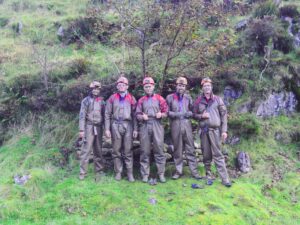
This is a very popular cave to explore with novices as it requires no tackle, is passable in all but the most extreme weather and the group can be turned around easily (good for larger groups or cavers of uncertain stamina). It is however quite boring and is unlikely to inspire many new people to return to caving over other outdoor pursuits. Avoid if you are not willing to clean lots of mud off your club gear and yourselves. Possible to get very lost at a couple of turn-offs, so carry a good survey/route description, available in Not for the Faint Hearted.
Susceptibility to rainfall and prevailing wet conditions: 1
SRT difficulty: 0
Route finding difficulty: 3
Link Pot
A splendid route into the southern end of Ease Gill Caverns (much better and cleaner than Mistral). A 12m ladder descent in a narrow rift open to the surface is a little awkward, but once you’re down, a diverse variety of passages can be explored very much by trial and error and a little guidance from route descriptions (new Northern Caves) and surveys. Exploration as far as Serendipity is possible without additional tackle and makes for an interesting short adventure. Serendipity itself requires SRT and dry, settled weather for a descent; the passage at the bottom, Easy Street, is well worth a look if weather and rope skills allow.
Susceptibility to rainfall and prevailing wet conditions: 2
SRT difficulty: 1 (12m ladder pitch in narrow rift from surface)
Route finding difficulty: 4
Trips with simple SRT
Bull Pot of The Witches
A very popular beginners cave which can be accessed in most weather conditions other than serious flood with minimal tackle, especially if the entrance pitch is laddered. Many pitches are easy SRT or may be free-climbed. A reasonable variety of passages are available to explore, and difficulty can be varied quite a bit depending upon the groups desire – pitches can be rigged lower down for a different route to the sump, for example. Being only a two minute walk from Bull Pot Farm, this is a popular Friday night trip!
Susceptibility to rainfall and prevailing wet conditions: 2
SRT difficulty: 1-2
Route finding difficulty: 3
Lancaster Hole to Wretched Rabbit (Ease Gill Caverns High Level Traverse)

This caving trip is a very popular choice as a first SRT trip which is accessible in all but extreme weather conditions (assuming Eureka Junction is avoided when exiting Wretched Rabbit, with cavers instead exiting via Four Ways Chamber in wet weather). This route is also an essential ‘backbone’ to Ease Gill Caverns to learn to assist with further future exploration.
Lancaster Hole involves a simple entrance shaft where it is easy for leaders to safely observe less experienced team members at rebelays. Throughout the route there are some entertaining rope climbs and handlines, excellent formations and very impressive passages. Route finding is likely to present challenges to those unfamiliar with Ease Gill Caverns, though it is still relatively straight-forward especially if the CNCC or Not for the Faint Hearted route descriptions are used. There are, however, a lot of passages to get lost in if you stray from the route, so be very wary as it could take a very long time for a rescue party to locate a lost team in this cave. It is advised that you keep SRT kits on for the trip as they will be needed at Fall Pot and Stake Pot to make safe descents into these large chambers.
The full through trip can be done in as little as 2.5-3hr, however for a novice group with several route-finding stops and a more leisurely pace, 5 hr is more realistic, but allow significantly more. Be prepared to turn around with plenty of spare time if you cannot find the way on.
Susceptibility to rainfall and prevailing wet conditions: 1-2
SRT difficulty: 2
Route finding difficulty: 4
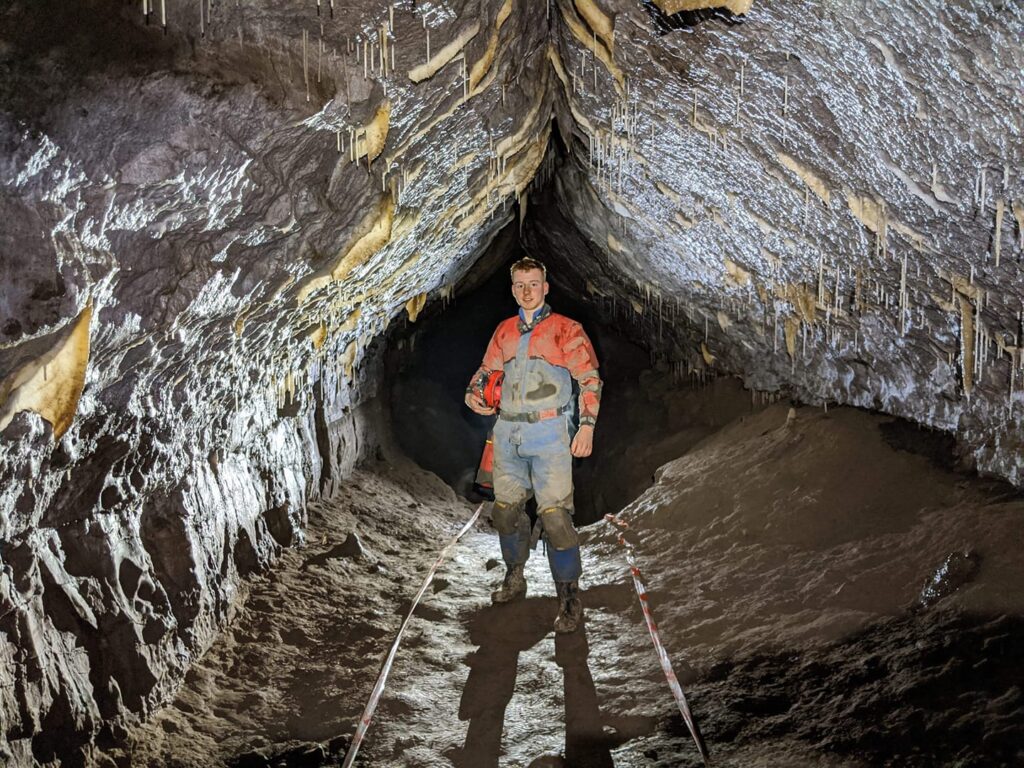
Trips with Advanced SRT
Cow Pot
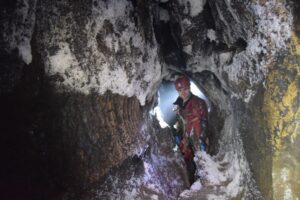
This is a popular choice for those looking to extend a group’s SRT experience (though discretion is necessary on the main pitch into Fall Pot, which is dangerous in wet weather). The main pitch has a deviation and two free-hanging rebelays, the second being very technical. This entrance can be combined with a look at the spectacular Lancaster Hole Main Drain between Fall Pot and Stake Pot (or continuing further up to Oxbow Corner) and a return along the High Level Route. Alternatively, you can make an exchange with Lancaster Hole. Use the CNCC route descriptions for inspiration – for example (in settled weather) a visit to the Downstream Sump via Wilf Taylors Passage is a great trip. Cow Pot has an awkward and tight free climb down a slot which is strenuous, tiring and time-consuming on the upward journey.
Susceptibility to rainfall and prevailing wet conditions: 4
SRT difficulty: 4
Route finding difficulty: 2 (just Cow Pot) or 3-4 (if exploring further from Fall Pot).
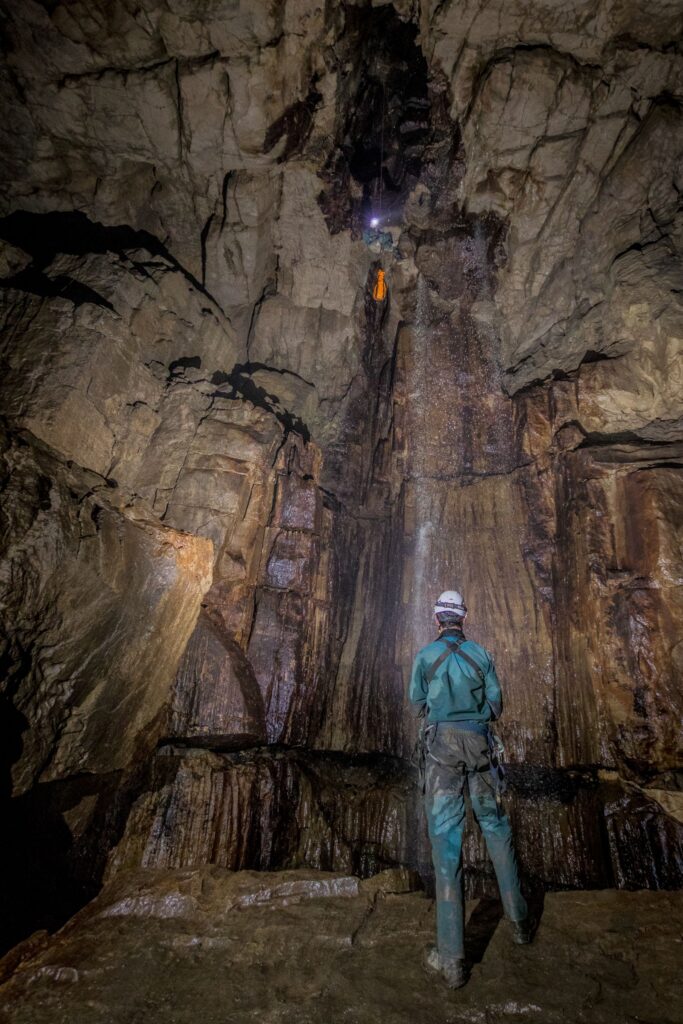
Pool Sink
An entertaining SRT route into the Ease Gill Main Drain with several simple pitches and some fine passage. Once you are familiar with the route, it is possible to undertake the route as a pull-through and to then exit via Wretched Rabbit – an excellent trip. Pull-through trips must only be attempted if you have complete confidence in the route all the way out. Always take multiple ropes in case one gets stuck, so you don’t end up stranded between pitches. An exploratory wander around the Main Drain and the nearby passages of Straw Chamber, Easter Grotto and Nagasaki (use the CNCC description) are great additions to a return trip. In wet weather, the entrance and pitches can flood, so avoid in unsettled conditions.
Susceptibility to rainfall and prevailing wet conditions: 4
SRT difficulty: 3
Route finding difficulty: 4
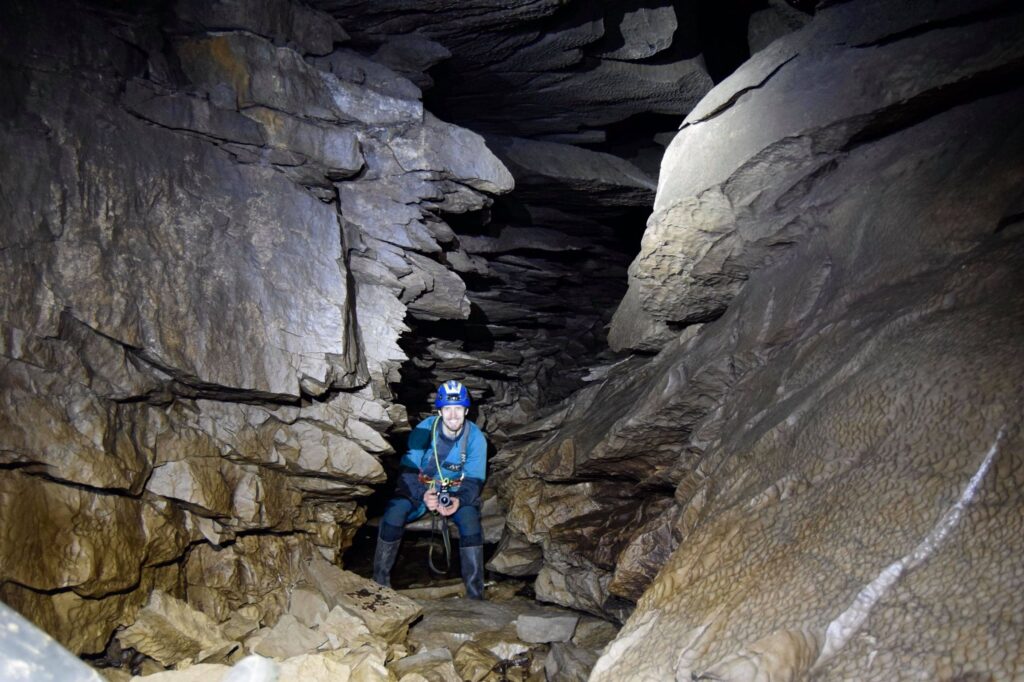
Shuttleworth Pot
Although this cave is really on Leck Fell, it is more usually approached from Bull Pot Farm. A normally dry entrance pitch series leads to a beautiful network of passages with some incredible formations: please read the conservation guide on the CNCC website to make sure you minimise your impact upon this unique environment. A good option for a Sunday trip.
Susceptibility to rainfall and prevailing wet conditions: 2
SRT difficulty: 3
Route finding difficulty: 2
Leck Fell
Trips with no SRT
Notts 2 (aka Committee Pot)

A famously beautiful cave with a fantastic streamway and loads of cool geology to match; an inspirational trip for newer cavers. A trip to both the downstream and upstream sumps (good description on the CNCC website) is a great outing for novices and experienced cavers alike. No SRT is required as the entire entrance can be climbed using the shoring (the entrance was extensively dug). However, it’s worth taking a rope to belay newer cavers down this. Also, the flow in the streamway can be very dangerous in high water – avoid if heavy rain is forecast. Please take care particularly around the vulnerable upstream formations.
Susceptibility to rainfall and prevailing wet conditions: 3-4
SRT difficulty: 0
Route finding difficulty: 3
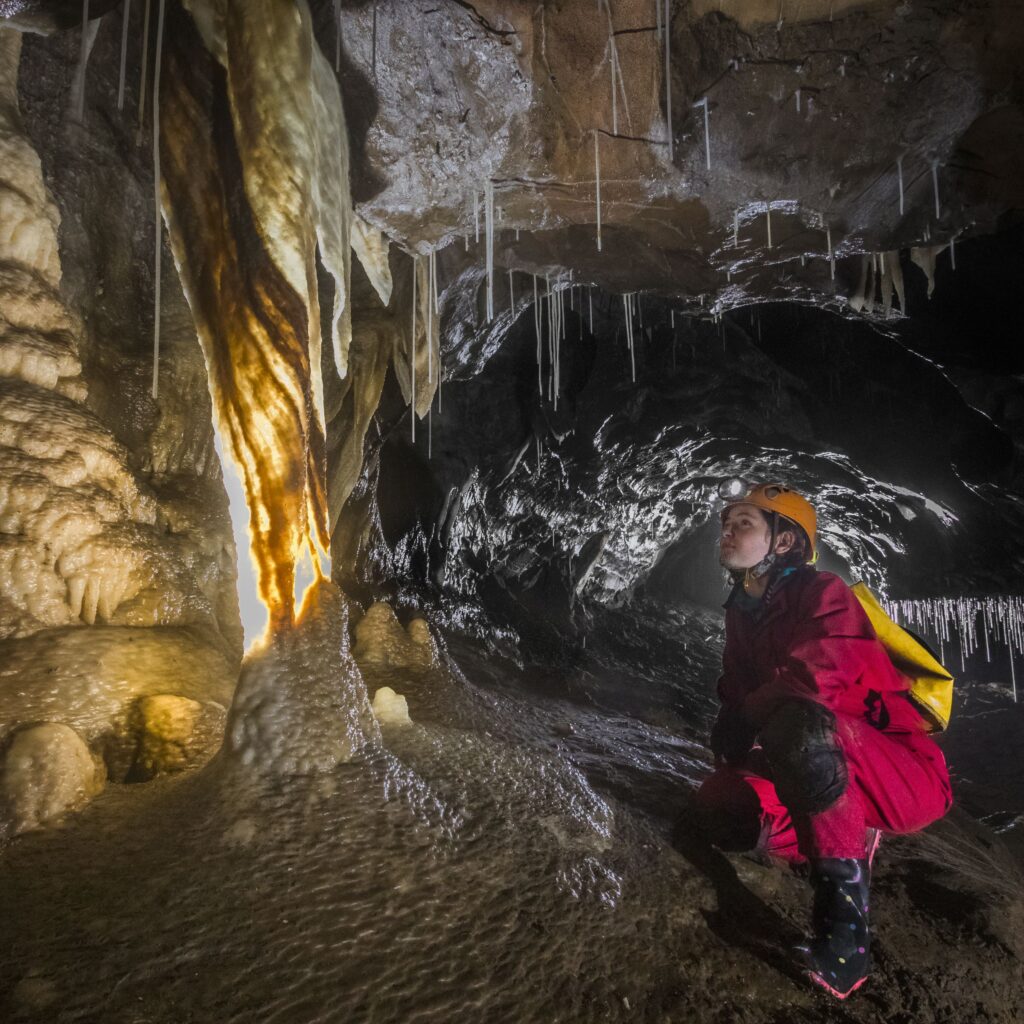
Trips with simple SRT
Short Drop Cave to Gavel Pot

A cute little trip, involving one short pitch down (Short Drop), an SRT traverse, and a short pitch back up (Gavel Entrance), with great views of Gavel and some nice formations. A good first SRT trip. Short Drop entrance can flood so not one for very wet days.
Susceptibility to rainfall and prevailing wet conditions: 3
SRT difficulty: 1-2
Route finding difficulty: 2
Lost Johns’ Cave Centipede Route as far as Battleaxe

Centipede route in Lost Johns’ Cave is by far the simplest, and requires no complex SRT, just three simple direct hangs with easy traverses. Candle and Shistol pitches which follow are also short and quite easy and easy to supervise cavers on. Less experienced groups will then want to turn around at the start of Battle-axe Traverse, as things get more technical from here.
Susceptibility to rainfall and prevailing wet conditions: 3
SRT difficulty: 2-3
Route finding difficulty: 2
Trips with advanced SRT
Lost Johns’ Cave: Cathedral-Dome / Mud-Centipede exchange
A really good SRT-heavy cave which has some excellent passage. The suggested trip, a Cathedral-Dome / Mud-Centipede exchange, has dry pitches which are good places to practice SRT. The entrance streamway can apparently sump the entrance in really extreme weather and will be hazardous in wet conditions, so avoid if a lot of rain is forecast. The Valhalla pitch below the Battle-Axe Traverse and the Leck Fell Master Cave below that are well worth the extra hour or two to visit in dry, settled weather. Read the descriptions on the CNCC website for inspiration for more trips in this cave: possibilities for exchanges and through-trips to other caves on Leck Fell are endless.
Susceptibility to rainfall and prevailing wet conditions: 3 (to Valhalla)
SRT difficulty: 4
Route finding difficulty: 3
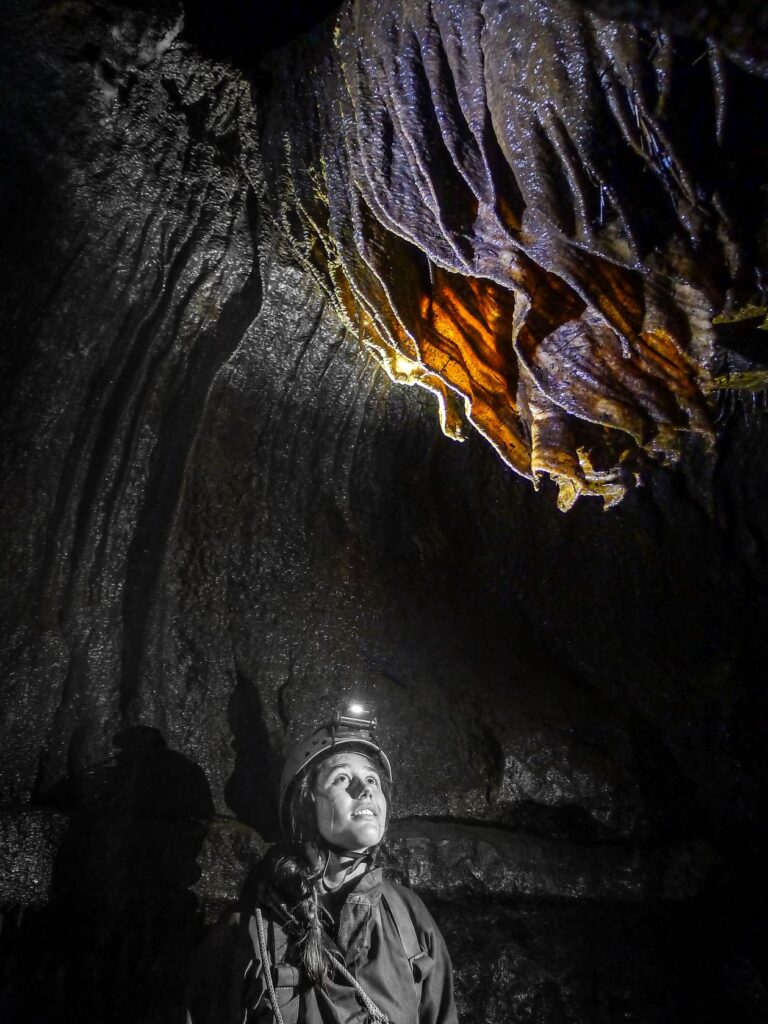
Notts Pot
A seriously vertical cave with a bewildering offering of SRT routes to the bottom. The majority of first-time visitors will use the Central and Left-Hand Routes down to the lower streamway. Notts is a commonly used wet-weather trip, although in very high water the penultimate pitch is highly sporting and the final short pitch impassable. The cave offers a great chance for experienced SRT users to polish their skills and get some rigging practice. Not for anyone who is new to SRT: there are a lot of rebelays and they will get tired!
Susceptibility to rainfall and prevailing wet conditions: 2 (3 for final two pitches)
SRT difficulty: 4-5
Route finding difficulty: 2-3
Deaths Head Hole
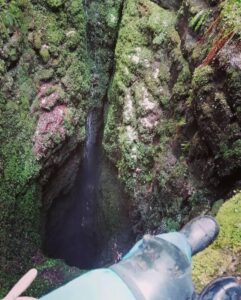
Another vertical offering which if done as a return trip is considered an option for wet weather. The return trip offers a great chance for experienced SRT users to polish their skills and get some rigging practice and the cave is close to the road. If you want to do an exchange with Big Meanie or other caves in the Leck Fell area which are all connected by the Master Cave, much drier conditions are needed.
Susceptibility to rainfall and prevailing wet conditions: 2 (just Deaths Head)
SRT difficulty: 4
Route finding difficulty: 1
Gavel Pot
Although Short Drop to Gavel is covered above, continuing down Gavel Pot offers some more technical SRT and a few stunning damp pitches. The terminal sump of Gavel is certainly a memorable place – diving in this sump resulted in the connection between the caves of Leck Fell and Ease Gill. A trip to the bottom of Gavel from Short Drop is an excellent day out.
Susceptibility to rainfall and prevailing wet conditions: 4
SRT difficulty: 4
Route finding difficulty: 2
Rumbling Hole
A stunning open-air entrance pitch usually well-watered by spray, leading into a classic series of underground pitches. Clean and uncomplicated; classic Dales potholing.
Susceptibility to rainfall and prevailing wet conditions: 4
SRT difficulty: 4
Route finding difficulty: 1
Marble Steps and Ireby Fell
There are a number of more advanced trips that can be done on Marble Steps and Ireby Fell, but these require high levels of fitness and SRT competence and dry, settled weather.
Trips with simple SRT
Ireby Fell Cavern to Duke Street Return Trip
Quite simply one of the best trips in Yorkshire with a great variety of passage and something for everyone. This cave is another good place to take people to practice rigging for the first time as it is easy to closely watch what the rigger is doing at all times. However, the way that the cave responds in flood is very variable depending on how water sinks, and its response to heavy rain has changed a lot in recent years (the former ‘flood route’ at the entrance is taken by water in much less wet conditions now), so avoid shortly after heavy rain and if rain is forecast.
Susceptibility to rainfall and prevailing wet conditions: 4
SRT difficulty: 3
Route finding difficulty: 3
Kingsdale
Most of the trips given here are on West Kingsdale. The caves of East Kingsdale are generally much more involved and floodprone outings requiring high levels of fitness and experience, though Vesper Pot offers a good introduction to the caves on this side of the dale. Not For the Faint Hearted has fantastic route descriptions of the East Kingsdale caves.
Trips with no SRT
Valley Entrance
A nice bimble to have a look up Kingsdale Master Cave and its inlets is a pleasant way to get a trip in. There is one small pitch (down into the Master Cave) that can easily be laddered. The Master Cave becomes dangerous in wet weather: do not descend into the water if it is high as the sump is right there and people have been washed into the sump and died in wet weather in the past. Possible to visit some extensions in Toyland for added interest if you want to do some more advanced ropework.
Susceptibility to rainfall and prevailing wet conditions: 2 (Roof Tunnel) – 4 (Master Cave)
SRT difficulty: 1
Route finding difficulty: 1
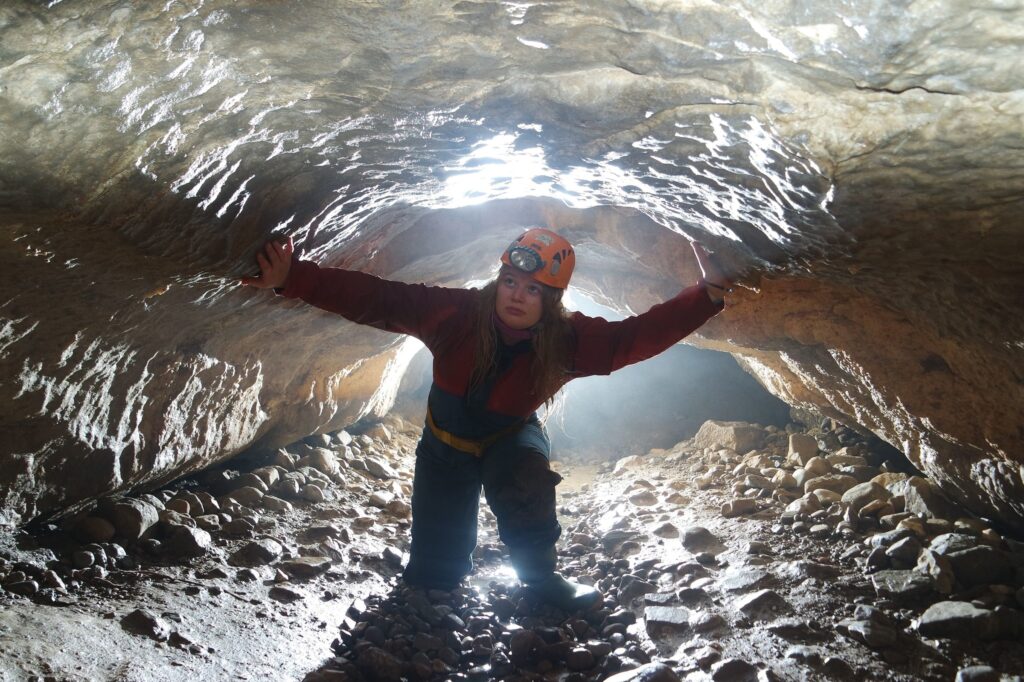
Rowten Cave, Jingling Cave, Simpson’s Cave
On a nice sunny day, what could be finer than a bimble along the Turbary Road at the top of West Kingsdale. With basic caving kit (no SRT) you can explore Rowten Cave and its tributary, Jingling Cave (take care as these flow into Rowten Pot), and Simpson’s Cave. See Northern Caves 3 for descriptions, each are about 300m and should take only 15 minutes each to explore, but combined with a picnic on a sunny day what could be better?
Susceptibility to rainfall and prevailing wet conditions: 4 (only fun on a sunny day)!
SRT difficulty: 0
Route finding difficulty: 1
Illusion Pot
A very pretty, non-SRT trip that offers a simple route into the Expressway passages at the end of Dale Barn Cave, which requires several ducks to be navigated just after the entrance. After prolonged rain, some of these ducks will sump, and can take several weeks to drain. Bailing buckets are available so a trip is possible if you are prepared to spend a while bailing, but it’s easier to just avoid this cave if the sump is present or if a lot of rain is forecast during the day. If you misjudge it you risk a long wait on the wrong side of daylight… No CNCC description at the time of writing, but it is described in the new Northern Caves and Caver Keith has done a video of the trip on YouTube so you can get an idea of what is involved.
Susceptibility to rainfall and prevailing wet conditions: 3
SRT difficulty: 0
Route finding difficulty: 2
Trips with simple SRT
Heron Pot
This trip is a very refreshing excursion not far from the road that offers a nice introduction to pull-through trips. The classic route (following the water) has two pitches, and both are short. However, the exit is a duck through a low crawl in the water that can sump: you should check the level of this water on the walk up before committing to the pull-through (and always take two ropes to avoid getting stranded in between the two pitches if one rope fails to pull down)! If in doubt, it can be hard-rigged as a return trip. A high traverse route, also shown on the topo, provides an exciting (and more wet-weather compatible) alternative for a return trip.
Susceptibility to rainfall and prevailing wet conditions: 2 (high traverse) / 4 (classic pitches)
SRT difficulty: 3
Route finding difficulty: 1
Yordas Pot
A short cave system very close to the road at the top of Kingsdale. A huge walk-in main chamber can be reached via a middle or top entrance further up the gully. The Chapter House pitch is simplest as a pull-through in dry weather, but can be hard-rigged away from falling water, thus creating a much more technical route involving an exposed traverse, a hanging traverse, rebelay and tight deviation all in quick succession.
Susceptibility to rainfall and prevailing wet conditions: 3-4 (hard-rigging) / 4 (pull-through)
SRT difficulty: 2 (pull through) / 4 (hard rigging of Chapter House pitch)
Route finding difficulty: 1
Jingling Pot
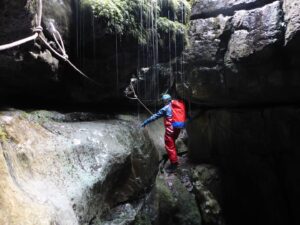
A classic open pothole, ranking up there with Bar Pot and Sell Gill Dry Route as a classic training venue for those new to underground SRT. Requires prior overground training in SRT and pitch safety. Multiple routes with differing technical difficulties. Passable in moderately wet conditions but in very wet weather a torrent of water enters the pothole making it hazardous.
Susceptibility to rainfall and prevailing wet conditions: 2-3
SRT difficulty: 3
Route finding difficulty: 2
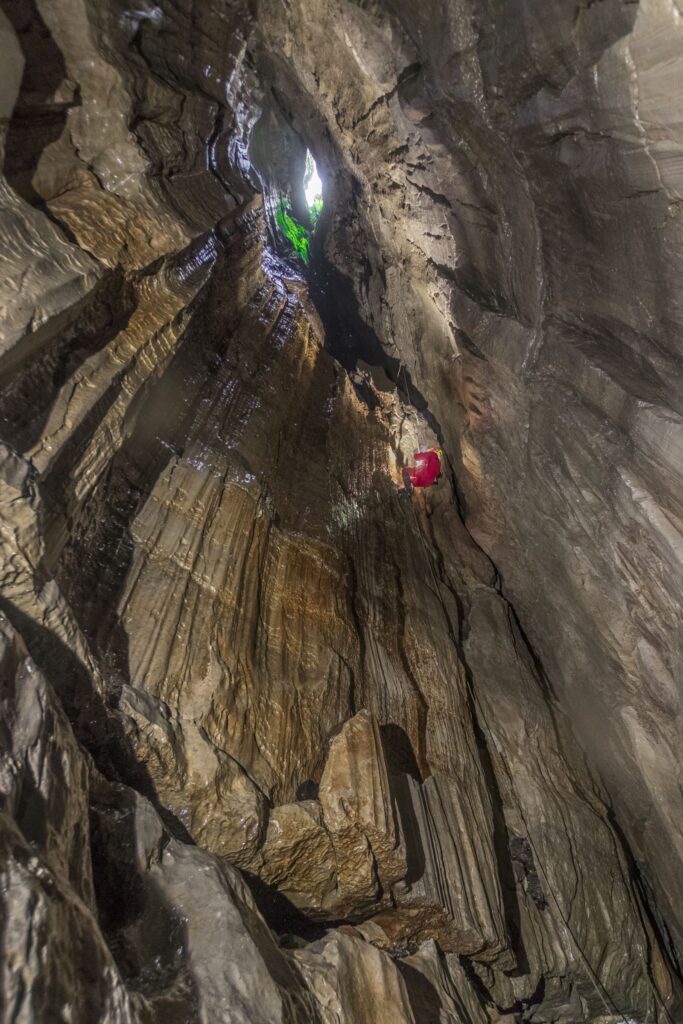
Bull Pot
Bull Pot is a classic trip to start putting slightly more advanced SRT principles into action underground as part of a group’s training. A bit of traversing, a rebelay or two, some deviations all in quite a short space of time. Bull Pot becomes sporting and dramatic in damp conditions but remains passable, although in very wet conditions it is best avoided.
Susceptibility to rainfall and prevailing wet conditions: 3
SRT difficulty: 3
Route finding difficulty: 2
Trips with advanced SRT
Aquamole Pot
A trip where almost all your time is spent on rope so good for practicing those skills. Often said to be a good option in wet weather, but even then, the fact it involves so much rope should make you think twice about its suitability in torrential conditions.
Susceptibility to rainfall and prevailing wet conditions: 2-3
SRT difficulty: 4
Route finding difficulty: 1-2
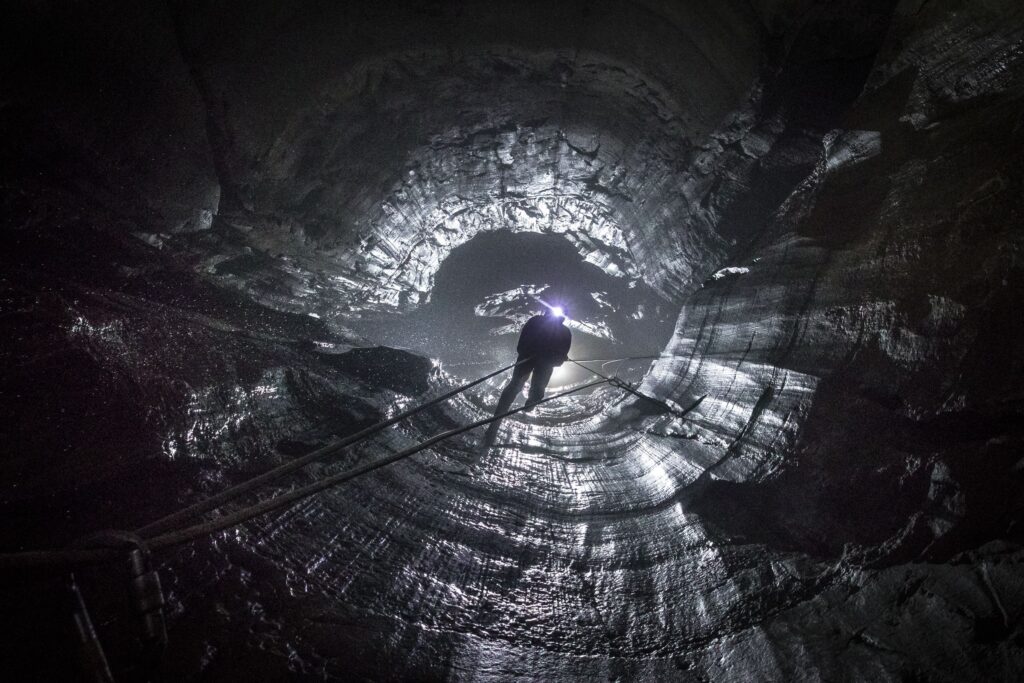
Rowten Pot Return Trip via Eyehole Route
Rowten is one of the mega vertical adventures in the Dales featuring a spectacular main pitch. Despite being an extremely active pothole, the anchor placements allow a descent via the Eyehole/Flyover route in reasonably wet conditions but not biblical flood. When very wet, the descents are very close to the waterfalls, the big pitch has loads of spray and the bottom of it can become a very cold, intimidating and exposed place requiring a much higher level of general caving experience to tackle it than when dry. In dry and settled conditions the Gully Route is a great alternative to the Eyehole.
Susceptibility to rainfall and prevailing wet conditions: 3
SRT difficulty: 4 – 5
Route finding difficulty: 1–2
Simpson’s Pot
A really splendid trip which follows a stream all the way through to Kingsdale Master Cave via a multitude of pitches. The final pitch, Slit Pot, is narrow at the top and can be difficult to rig and descend for those not confident in their SRT skills, but Swinsto Great Aven offers an alternative. Often done as a pull-through but there is no reason not to do it as a return trip. There is a duck part way down that can sump in wet weather. If undertaking the pull-through don’t descend The Pit (see CNCC description), and always carry spare ropes in case one jams while pulling down. As always, pull-through trips are only to be attempted if completely confident in finding the route out via Valley Entrance and that the water levels are sufficiently low. The entrance can be hard to find – consider using a GPS and have a photo.
Susceptibility to rainfall and prevailing wet conditions: 4
SRT difficulty: 4
Route finding difficulty: 2-3
Swinsto Hole
An excellent trip which follows a sporting stream all the way through to Kingsdale Master Cave. Often done as a pull-through but there is no reason not to do it as a return trip. As always, pull-through trips are only to be attempted if absolutely confident in finding the route out via Valley Entrance and that the water levels are sufficiently low. Carry multiple ropes. The long crawl is not nice in wet weather, the pitches can flood badly and they can be intimidating with lots of spray. Entrance can be hard to find – consider using a GPS and have a photo.
Susceptibility to rainfall and prevailing wet conditions: 4
SRT difficulty: 4
Route finding difficulty: 2-3
Vesper Pot
If you are looking for a bit of an introduction to slightly more acrobatic and awkward caving in Yorkshire, but without too much hardship, and plenty of ‘smile’ moments, head to Vesper Pot on East Kingsdale! The narrow entrance crawl quickly enlarges and a selection of varied, but often narrow pitch heads follow, ending with a spectacular few spacious pitches to The Great Rubble Heap. Vesper Pot can be tackled in moderately wet conditions, but the final pitch develops lots of spray, and the bottom of the pitch isn’t somewhere you would want to hang around.
Susceptibility to rainfall and prevailing wet conditions: 2-3
SRT difficulty: 5
Route finding difficulty: 2
Chapel le-Dale
Trips with no SRT
Great Douk Cave to Middle Washfold Cave
Classic little bimble that is ideal for complete novices. Avoid in wet weather, the cave floods.
Susceptibility to rainfall and prevailing wet conditions: 4
SRT difficulty: 0
Route finding difficulty: 1
Trips with simple SRT
Sunset Hole
Follows an active stream down a series of short climbs/cascades (handlines advised) to a 25 m pitch into a final chamber. Avoid in wet weather as the climbs will become hazardous.
Susceptibility to rainfall and prevailing wet conditions: 4
SRT difficulty: 1-2
Route finding difficulty: 1
Trips with advanced SRT
Tathams Wife Hole
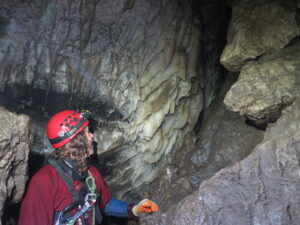
A classic trip which follows an active stream down a series of short pitches (could be done on ladders if you like) to a duck and more stream passage and a final pitch to wet passages beyond (wetsuit advised if attempting these final passages). Avoid in wet weather as the pitches will become hazardous. Entrance can be hard to find: have a GPS/map and compass and entrance photo. Even if visibility is good when heading underground, have a plan for navigating back to the car for if the weather comes in while you are underground.
Susceptibility to rainfall and prevailing wet conditions: 4
SRT difficulty: 3
Route finding difficulty: 2
Gaping Gill
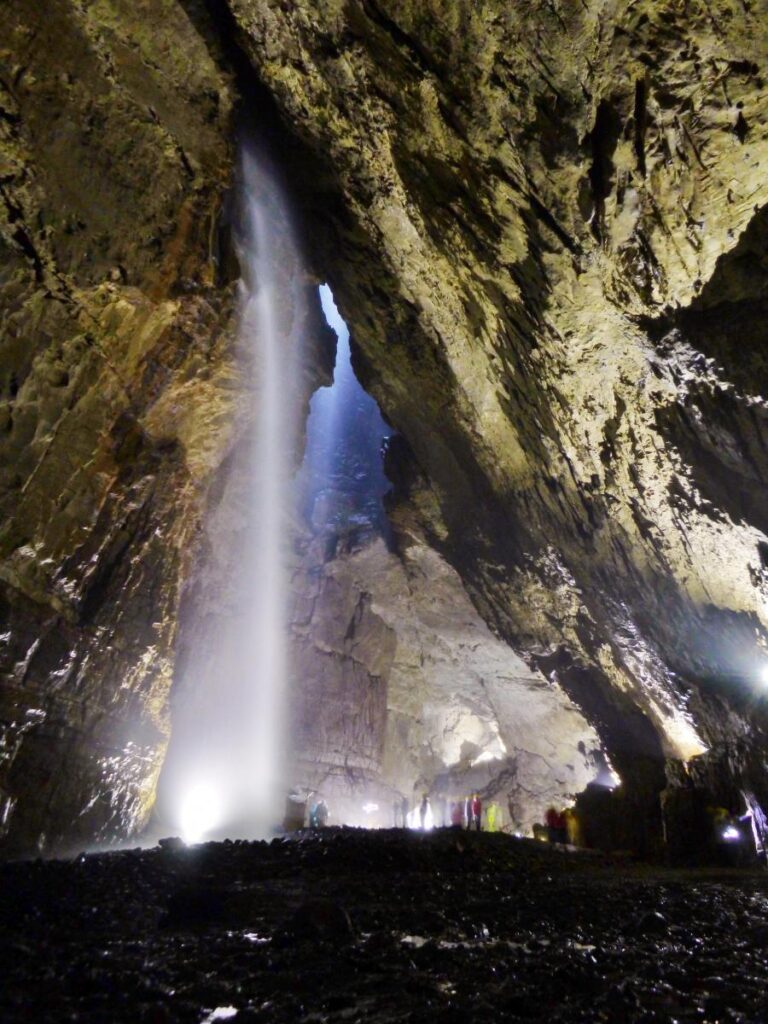
Trips with simple SRT
Bar Pot to Main Chamber via Small Mammal Entrance
Bar Pot is a classic SRT trip which, due to being pretty weather-proof, is usually very busy on wet days. Unfortunately, there is a bottleneck at the entrance pitch which is constricted at the top, making it slow going with newer cavers. A simple way of avoiding this tedious pitch is to make use of the next-door entrance of Small Mammal which is spacious and uses a similar amount of rope. After you have done this once you will never use the Bar Pot entrance again.
Susceptibility to rainfall and prevailing wet conditions: 1
SRT difficulty: 3
Route finding difficulty: 2
Trips with advanced SRT
Flood Entrance (via Wades) to Main Chamber
This trip is not as flood-prone as its name implies but it does take a stream and has a lot of SRT so be cautious in wet weather. The final pitch has a tricky hanging rebelay that will cause a lot of delays for those inexperienced with SRT so unless you want to get very cold then keep your group small and select. Good to do as an exchange trip with Bar Pot for a more varied trip.
Susceptibility to rainfall and prevailing wet conditions: 3
SRT difficulty: 4
Route finding difficulty: 2
Stream Passage Pot to Main Chamber

A real Yorkshire SRT adventure with lots of swinging about on ropes doing big deviations to keep you clear of the water. The last sentence should tell you that if you aren’t experienced at SRT this is a trip to avoid. Great for those who have done the other trips listed for GG and want to try something a bit more challenging. Navigating to Main Chamber via Sand Caverns can be a bit confusing for first-time visitors.
Susceptibility to rainfall and prevailing wet conditions: 4
SRT difficulty: 4
Route finding difficulty: 3
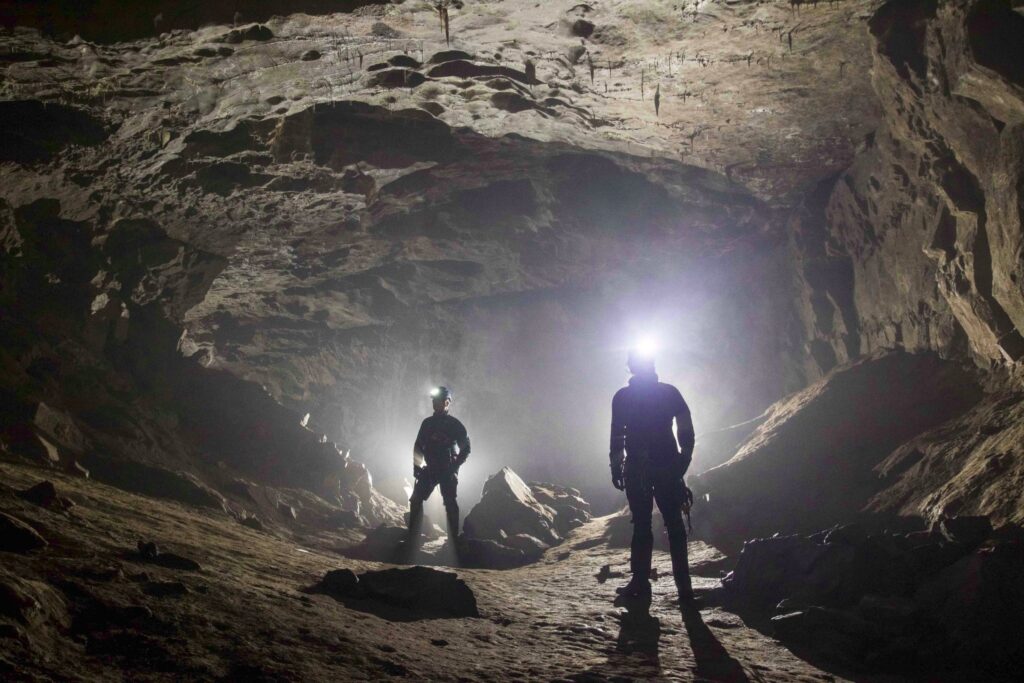
The Allotment
The Allotment on Ingleborough offers little to groups with novices, and the long walk up (needing map and compass) deters the casual visitors. However, once your team know what they are doing with SRT underground, these three trips are just splendid.
Trips with advanced SRT
Juniper Gulf
A Yorkshire Classic, a multi-pitch adventure with lots of traversing and an epic final big pitch.
Susceptibility to rainfall and prevailing wet conditions: 4
SRT difficulty: 4
Route finding difficulty: 2
Rift Pot
A great trip for experienced cavers on a wet day, two routes to the bottom and some exciting SRT scenarios. Watch out for loose rocks all the way down.
Susceptibility to rainfall and prevailing wet conditions: 1-2
SRT difficulty: 4
Route finding difficulty: 2-3
Long Kin East
Connects at the bottom with Rift Pot for a stunning exchange. However, unlike Rift Pot, this is an extremely active pothole so dry weather is essential.
Susceptibility to rainfall and prevailing wet conditions: 4-5
SRT difficulty: 4
Route finding difficulty: 2
Selside
Trips with no SRT
Upper Long Churn Cave (and others nearby)
Classic little bimble that is close to the road and ideal for novices. Avoid in wet weather, the cave floods severely and rapidly. Other surrounding caves (e.g. Wilson’s Cave, Borrins Moor Cave) can also be explored. A wetsuit adds to the enjoyment of these caves.
Susceptibility to rainfall and prevailing wet conditions: 4
SRT difficulty: 0
Route finding difficulty: 2
Trips with simple SRT
Upper Long Churn Cave to Alum Pot via Dolly Tubs
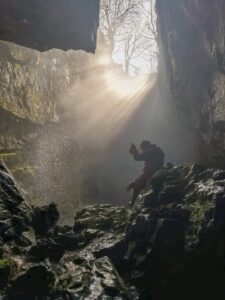
A classic SRT trip which is usually busy because it’s a short walk from the road, the SRT is simple and the views into Alum Pot from Dolly Tubs Ledge are very beautiful (one of the most iconic cave photos in the area). Again, the entrance is flood-prone.
Susceptibility to rainfall and prevailing wet conditions: 4
SRT difficulty: 2-3
Route finding difficulty: 2
Trips with advanced SRT
Alum Pot
A classic pothole with two main SRT routes to the bottom. Both involve a long hang with quite a lot of prussiking and hanging rebelays so if you have a slow or large party have a group shelter ready for people to wait in when they are on the surface. At least everyone will be able to see what they’re doing – the shaft is in broad daylight most of the way. Very beautiful on a winter day. The North West route is the most suited to slightly damp conditions.
Susceptibility to rainfall and prevailing wet conditions: 3 (NW route), 4 (SE route)
SRT difficulty: 4
Route finding difficulty: 1

Penyghent and Fountains Fell
Trips with no SRT
The following three novice-friendly trips are located at High Birkwith. Unfortunately, the access situation here, including parking, is volatile at the time of writing (and is likely to remain so for some time) so check the CNCC website for the most up to date information. Parking may only be possible at Selside or Horton so a walk may be required.
Birkwith Cave
Classic little bimble that is ideal for novices. Avoid in wet weather, the cave floods severely and rapidly.
Susceptibility to rainfall and prevailing wet conditions: 4
SRT difficulty: 0
Route finding difficulty: 1
Old Ing Cave
Classic little bimble that is ideal for novices. Avoid in wet weather.
Susceptibility to rainfall and prevailing wet conditions: 3-4
SRT difficulty: 0
Route finding difficulty: 1
Calf Holes to Browgill Cave

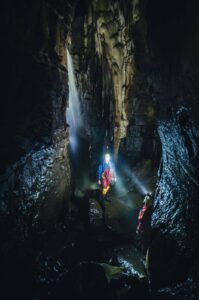
A nice wee through trip that is ideal for novices if the Calf Holes entrance pitch is rigged as a ladder. Avoid in wet weather as the cave floods. The trip can easily be combined with visits to Old Ing and Birkwith to produce a great introductory day of caving. Walking between the entrances is pleasant on a sunny day; less so in heavy rain, but if it’s that kind of day then you should probably be caving elsewhere anyway…
Susceptibility to rainfall and prevailing wet conditions: 4
SRT difficulty: 0-1
Route finding difficulty: 2
Trips with simple SRT
Sell Gill Holes: Dry Entrance
A classic SRT trip which has simple and typically dry pitches in all but the worst conditions, though waiting on the surface for the first pitch to be rigged can be cold – have a group shelter for this. Not the most inspiring cave but very good as an introduction to SRT, much better than Bar Pot for this, and a splendid large passage/chamber at the bottom.
Susceptibility to rainfall and prevailing wet conditions: 1-2
SRT difficulty: 2-3
Route finding difficulty: 1
Trips with advanced SRT
Sell Gill Holes: Goblin Route
A worthwhile alternative route into Sell Gill if weather conditions and SRT experience allow (not for wet days or those new to SRT). Lots of exciting action in a very short distance and time.
Susceptibility to rainfall and prevailing wet conditions: 3-4
SRT difficulty: 3-4
Route finding difficulty: 1

Hunt Pot
Botch’s favourite cave. A good one for a lazy sunny day where a nice walk and lounging on the surface waiting for the rigger and admiring the slopes of Penyghent and Ingleborough are very pleasant. An interestingly shaped entrance as well. Worth a visit to avoid more crowded destinations.
Susceptibility to rainfall and prevailing wet conditions: 3-4
SRT difficulty: 3-4
Route finding difficulty: 1
FOUL Pot
For those wanting a good introduction to harder Dales caving, but nothing too severe to start with, FOUL Pot is a good option. The cave has a long pitch and a couple of squeezes, good formations and some interesting passage shapes. A great cave for experienced cavers to test their all-round cave fitness before attempting any of the more gnarly offerings across Fountains Fell. Although not one for heavy rain as some passages are flood-prone, FOUL should be fine in slightly damp conditions.
Susceptibility to rainfall and prevailing wet conditions: 3 – 4
SRT difficulty: 4
Route finding difficulty: 2
Little Hull Pot
An excellent SRT adventure with some good technical sections for rigging practice. The pitches are very aesthetically pleasing and there is a nice little stream followed all the way. Not for inexperienced cavers as there is quite a lot of SRT, some potentially loose rock and parts of the cave are flood-prone.
Susceptibility to rainfall and prevailing wet conditions: 3-4
SRT difficulty: 4
Route finding difficulty: 2
Good novice trips outside of the Three Peaks/Three Counties area
Crackpot Cave (Swaledale)
A splendid short but inspirational trip requiring no tackle and suitable for novices, with appropriate supervision to avoid damage to the formations. Great streamway, and at the end a climb up to a decorated chamber called The Turnip Field.
Susceptibility to rainfall and prevailing wet conditions: 3
SRT difficulty: 0
Route finding difficulty: 2
Dow Cave (Wharfedale)
Dow Cave is a stunning river passage and well worth seeing regardless of experience level. No tackle is required, but don’t go when the water is too high. Dow Cave connects to Providence Pot in the next valley south via Dowbergill Passage. This infamous passage is a Yorkshire classic, requiring no tackle but must be treated with extreme respect, as it is flood-prone, strenuous, has lots of tricky climbs and is navigationally deceptive. The ratings below are only for a visit into Dow Cave and not for Providence Pot/Dowbergill Passage.
Susceptibility to rainfall and prevailing wet conditions: 3-4
SRT difficulty: 0
Route finding difficulty: 2
Ibbeth Peril (Dentdale)
Several minutes of crawling/stooping reach an enormous, cavernous chamber. No tackle required. The entrance is by the side of a large waterfall in a river so dry conditions and low water levels are needed. The wider cave system is much more extensive.
Susceptibility to rainfall and prevailing wet conditions: 4-5
SRT difficulty: 0
Route finding difficulty: 1
Goyden Pot and Manchester Hole (Nidderdale)
A very extensive, connected system offering a comprehensive adventure for cavers of all abilities. Navigation is very challenging indeed and trips must therefore be well-researched. The entire system can flood severely. Always check for Scour tests at Scar House Reservoir – if this empties while you are in the cave you are in very deep shit!
Susceptibility to rainfall and prevailing wet conditions: 4-5
SRT difficulty: 0 (route-dependent)
Route finding difficulty: 4
Dowkabottom Cave (Littondale)
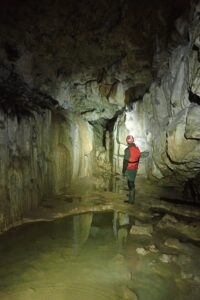
A really interesting percolation-fed cave located in the bottom of an impressively huge depression. A great option for complete novices: no tackle is required, there is a good variety of passage but with minimal chance of getting lost and the cave remains passable in most weather conditions (Northern Caves says there is a duck, but this feature has been engineered to allow it to drain easily which greatly reduces susceptibility to wet weather). Parking (at Sleets Gill Cave) is slightly limited but more parking is available a short walk up the road. A much overlooked gem in a beautiful corner of the Dales.
Susceptibility to rainfall and prevailing wet conditions: 1-2
SRT difficulty: 0
Route finding difficulty: 1-2
Compiled by CHECC and CNCC, November 2020.
Huge thanks to all the student photographers who have kindly contributed their photographs for this guide, crowd-sourced from the CHECC community.